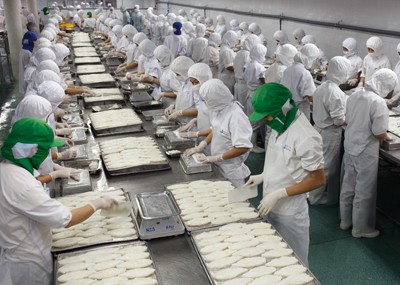News
Asian Economy 2015: Dark and Light
Update: 2/3/2015Asian Economy 2015: Dark and Light
 The negative signal from the leading economies in Asia raised fears about the looming growth prospects of the countries in the region in 2015. However, the challenges that Asia will face are not only an issue of big countries, but also inside each country in the continent.
The negative signal from the leading economies in Asia raised fears about the looming growth prospects of the countries in the region in 2015. However, the challenges that Asia will face are not only an issue of big countries, but also inside each country in the continent.
The economic crisis suddenly returned to Japan in the final months of 2014 when the 3rd largest economy in the world had to grapple with the consequences of raising the consumption tax from 5 to 8 percent, which came into effect since April last year. This has forced the people to be more careful when calculating spending and increasingly tightening their wallets at the prospect of consumption taxes continuing to rise over the next few years.
Meanwhile, China, the largest economy in Asia, is now facing limited growth and economic imbalances, resulting from shrinking civil construction market and rising bad debts because credit has grown so fast since 2009. Declining home prices along with tight management of building will make the economy slow down.
In the context of the growth of the Chinese economy showing signs of slowdown and Japan trying to escape from the 3rd crisis over the recent 2 years, in some studies, economists have revised down economic growth forecast for the region's economy. Recently, the Asian Development Bank (ADB) has adjusted the forecast of total gross domestic product (GDP) of Asia in 2015 from 6.4 percent to 6.2 percent.
The negative signal from the leading economies in Asia raised fears about the looming growth prospects of countries in the region in 2015. However, the challenges that Asia will face not are only an issue of big countries, but also inside each country in the continent.
First, the gap between rich and poor is growing in Asia and it seems not to stop. The work of international economic integration, globalisation and the development of technology by storm is the cause of this problem. We can see that this process has brought strong growth in Asia through the opening of new export markets, rising labour productivity and improved labour skills.
However, these benefits seem only for central city areas where high quality human resources are abundant or at least those localities with favourable geographical positions consistent with the needs of investors. This poses a challenge to the governments in their planning policy of development of urban infrastructure and uniform throughout, and strategic investments in education. Of course, this can only be done with an abundant budget, and therefore governments must consider reasonable policies without creating new financial turmoil.
Second, corruption in emerging economies and developing countries has been causing extremely serious consequences, increasing injustice and destroying areas of society, and further downgrading the national prestige. Prevention of corruption is not new, but the efforts of the governments do not seem strong enough and synchronous. This is completely understandable, because in emerging or developing Asian countries, with limited economic options and financial management capacity, it will still take time and efforts to remove this problem completely.
Third, the seeds of geopolitical conflict in Asian countries are seen as a central issue attracting the attention of the world in 2014 and will continue in 2015. Any wrong decisions by countries which have territorial disputes may result in military conflict. This will definitely be a disaster for the economy which is still very weak, just starting to recover after the recent financial crisis.
We can say that Asia is moving into 2015 with many economic challenges. However, there is also a positive factor which may partially support the economic recovery in the region. This factor is the sharp decline in world oil prices during the second half of 2014. Most Asian countries are importers of petroleum products and therefore will benefit directly from this price reduction. Optimistic with the impact of oil prices, some economists also forecast GDP growth of the Asia - Pacific region in particular will be around 4.7 percent in 2015, slightly higher than the 4.6 percent of 2014.
While some OPEC countries are severely damaged because of falling oil prices, East Asia and Southeast Asia have the opportunity to promote economic growth. The economies which were based on exports now have the opportunity to promote domestic consumption due to the decline in production costs, operation and cargo. This will be the driving force for the region to continue to restructure the economy, lower interest rates and boost the private sector.
Entering 2015, the return of the United States to the leading position in the world economy will become a driving force for growth in Asia. Along with that is the prospect of Trans-Pacific Partnership (TPP) Agreement initiated by the United States which will become a real boost for the ability to produce and export goods of Asian participants.
The benefits of domestic growth and export market expansion are clearly visible, such as increased energy reserves and reduced inflation, growing consumption and production capacity. However, these benefits may be due to lower oil prices which probably will not last long. The passive engagement in trade agreements without careful calculation would be a double-edged sword for Asian countries. And so, identifying the real challenges that every country in Asia is facing and dealing with them will be key factors in creating a sustainable economy for each country and also the region.












